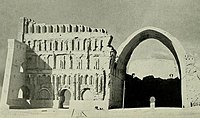Gazarta (Chaldean diocese)
The Chaldean diocese of Gazarta, named for the town of Jezira (modern Cizre), known in Syriac as Gazarta d'Beth Zabdai, was established on a stable basis in the early nineteenth century. Many of the Chaldeans of the Gazarta region, including the bishop of Gazarta Philip Ya[ʿ] Error: {{Transliteration}}: transliteration text not Latin script (help)qob Abraham, were killed during the Armenian massacres in 1915, and the diocese lapsed after the First World War.
Chaldean bishops of Gazarta
The first nineteenth-century Chaldean bishop of Gazarta was Giwargis Peter di Natale, who was consecrated for Gazarta in 1833 by the patriarch Yohannan VIII Hormizd and transferred to the diocese of [ʿ] Error: {{Transliteration}}: transliteration text not Latin script (help)Amadiya in 1842.
The patriarch Nicholas I Zay[ʿ] Error: {{Transliteration}}: transliteration text not Latin script (help)a appointed Basil Asmar, previously administrator of the diocese of Amid, to the diocese of Gazarta in 1842. Basil was metropolitan of Gazarta for nine years, and Badger noted in 1850 that 'he seldom resides at Jezeerah'.[1] He retired due to old age and ill health in 1851.
The patriarch Joseph VI Audo sent the priest [ʿ] Error: {{Transliteration}}: transliteration text not Latin script (help)Abdisho[ʿ] Error: {{Transliteration}}: transliteration text not Latin script (help) Dosho (later metropolitan of [ʿ] Error: {{Transliteration}}: transliteration text not Latin script (help)Amadiya) to Gazarta in his place for a year, and appointed Jerome Paul Hindi metropolitan of Gazarta in 1852. Hindi was metropolitan of Gazarta until 1873, and was succeeded by Eliya Peter [ʿ] Error: {{Transliteration}}: transliteration text not Latin script (help)Abulyonan (1874–8), who became patriarch in 1879 after Audo's death.
In 1875 the monk Philip Abraham of the monastery of Notre Dame des Semences, who was born in Telkepe in 1848 and became a priest in 1873, was consecrated metropolitan for India by Joseph VI Audo, who was then challenging the authority of the Padroado jurisdiction in India. He was recalled from India in 1881 by Eliya XII [ʿ] Error: {{Transliteration}}: transliteration text not Latin script (help)Abulyonan on instructions from the Vatican, and was transferred to the diocese of Gazarta in 1882, taking the name Mar Ya[ʿ] Error: {{Transliteration}}: transliteration text not Latin script (help)qob. He was among the many Chaldean clergy murdered in the Armenian massacres of 1915. He was the last metropolitan of Gazarta. The Chaldean population of the Gazarta district was greatly reduced in the First World War, and the diocese of Gazarta was not revived afterwards.
Population statistics
In 1867 the diocese of Gazarta contained 20 villages and had a population of 7,000 Chaldeans, served by 10 priests (Martin). In 1896 the diocese had a population of 5,500 Chaldeans, and contained 16 parishes or stations, 20 churches, and 14 priests, assisted by a Dominican mission and a mission of the Sisters of Preservation at Gazarta (Chabot). The largest villages in the diocese were Gazarta, Hoz and Mer, Harbol, Peshabur, Taqian, Girik Bedro, Wasta and Tel Qabin.
In 1913 the diocese included 17 villages, and had 17 priests and 6,400 believers (Tfinkdji).
The diocese was ruined in the First World War, and in 1928 there were only 1,600 Chaldeans remaining in its former territory, without a priest (Tisserant). In 1937 there were 2,250 Chaldeans, with a priest and a church (Kajo).
Notes
- ^ Badger, Nestorians, i. 69
References
- Baaba, Youel A., The Assyrian Homeland before World War I (Alamo, California, 2009)
- Badger, George Percy (1852). The Nestorians and Their Rituals with the Narrative of a Mission to Mesopotamia and Coordistan in 1842 to 1844 (two volumes). Kessinger Publishing. ISBN 978-1-4179-4675-4.
- Chabot, J. B., 'État religieux des diocèses formant le patriarcat chaldéen de Babylone au 1er janvier 1896', Revue de l'Orient Chrétien, 1 (1898), 433–53
- Fiey, J. M., Assyrie chrétienne (3 vols, Beirut, 1962)
- Fiey, J. M., Pour un Oriens Christianus novus; répertoire des diocèses Syriaques orientaux et occidentaux (Beirut, 1993)
- Giamil, S., Genuinae Relationes inter Sedem Apostolicam et Assyriorum Orientalium seu Chaldaeorum Ecclesiam (Rome, 1902)
- Martin, P., La Chaldée, esquisse historique, suivie de quelques réflexions sur l'Orient (Rome, 1867)
- Tfinkdji, J., 'L’église chaldéenne catholique autrefois et aujourd’hui', Annuaire Pontifical Catholique, 17 (1914), 449–525
- Tisserant, E., 'Église nestorienne', Dictionnaire de Théologie Catholique, 11, 157–323
- Wilmshurst, D. J., The Ecclesiastical Organisation of the Church of the East, 1318–1913 (Louvain, 2000)

